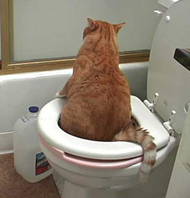News
Blocked Cats
by on February 27th, 2014
Category: News, Tags:
A ‘blocked’ cat describes a patient that can’t pass urine due to an obstruction. It is one of the true emergencies affecting cats and it can quickly become life-threatening (1-2 days). Any cat can be affected but it is much more common in males. It is therefore essential that everyone who lives with a male cat is aware of this condition.
What is a ‘blocked’ cat?
Like humans, cats have two kidneys which make urine by filtering the blood. Urine flows down (via tubes called ureters) from the kidneys into the urinary bladder; it is then excreted from the body through a tube called the urethra which connects the bladder to the outside. ‘Blocked cats’ are ones in which the urethra becomes obstructed preventing urine from being passed. Therefore the correct medical term for this blockage is a urethral obstruction.
Why is urethral obstruction more common in male cats?
In male cats the urethra runs from the bladder through the penis to the outside world. At a certain point there is a bend in the urethra and it becomes narrower; this is the main reason why male cats are much more commonly affected by urethral obstruction. In female cats the urethra is shorter, does not have a bend in it and does not become narrower.
Which male cats are more likely to be affected?
Urethral obstruction can be seen in all kinds of male cats but it is most common in ones that are:
- Overweight
- Confined indoors
- Fed dry food only
Many blocked cats are young or middle-aged and have been neutered – but the problem can occur in older cats and uncastrated ones as well.
What is it that blocks the urethra?
The urethra most often gets blocked by ‘plugs’ of material including protein, cells and little crystals and/or by stones (uroliths) formed from minerals. These substances are usually present in the urine in small amounts but they can build up and then cause an obstruction. This may be more likely in cats that do not consume enough water (either in their diet or by drinking) or that do not urinate often enough. Most blocked tomcats do not have a urinary tract infection.
Other much less common causes of urethral obstruction include tumours and in some cases a cause is not found.
Why is it a problem if the urethra becomes obstructed?
The body needs to be able to pass urine in order to get rid of substances (e.g. potassium, acid) that are harmful when they accumulate in the body. When the urethra gets blocked these substances are not removed, they build up in the cat’s body, and then have dangerous consequences making the cat extremely ill. The bladder often becomes hard and very painful for the cat as well.
How can I tell that my cat’s urethra may be obstructed?
It is important to realise that not all cats with urethral obstruction show the same signs. Some may just show non-specific signs such as being off their food or a little quieter than normal. Vomiting may occur, and at the opposite end of the spectrum some cats become very depressed and collapsed. There are some classical signs associated with urethral obstruction but remember that not all cats show these signs:
- Straining to urinate, maybe crying out when doing so
- Making frequent visits to the litter tray but only passing a few drops each time (‘spotting urine’)
- Discoloured urine due to blood
If your cat strains in the litter tray you should try and pay attention to whether they have passed faeces recently or not. Carers sometimes ring worried that their cat is constipated and then it turns out that in fact their bladder is blocked and the straining was because the cat is unable to pass urine.
Other signs that cats with urethral obstruction may show include:
- Walking abnormally at their back end – carers often mistakenly think the cat has had an accident of some sort
- Yowling as if in pain when picked up


